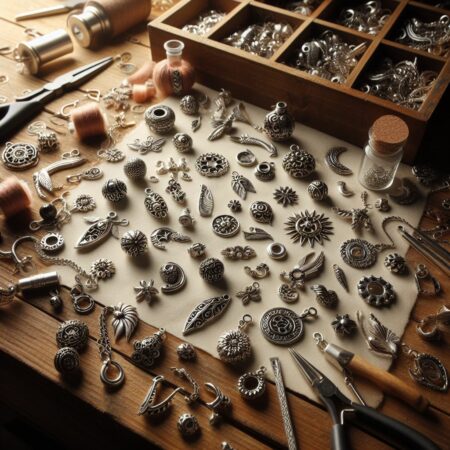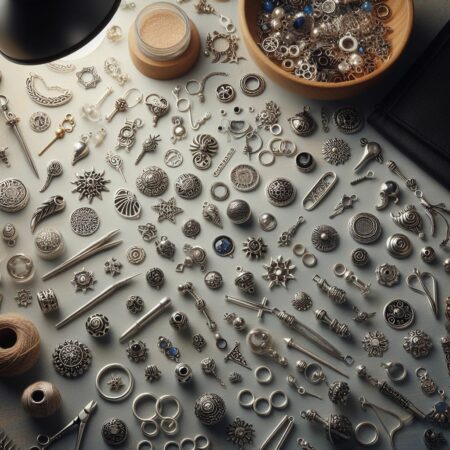The use of metals dates to the dawn of human civilization, thousands of years before their discovery. Jewelry was just one of many ways ancient Egyptians, Romans, and Greeks put them to use. Finally, around 6000 B.C., gold was found, and around 4000 B.C., silver.
Only a small subset of the metals available are used in the jewelry industry. Precious metals, also called noble metals, including gold, silver, and platinum. Compared to common metals, precious metals are highly sought after because of their rarity and high market value.
Non-precious or base metals are not gold, silver, or platinum and are much more affordable and accessible. Alloys can be made from any type of metal, precious or otherwise, and are used to alter the metal’s properties (such as its color and hardness).
If you’re not familiar yet with what findings are and how they’re used, please check out our guide on jewelry findings, where you’ll learn about items like jump rings and how to use them in designing jewelry with beads.
Where Metal Beads and Metal Findings Are Sourced
In this section, we’ll go over the basics of the different, common metal types used for manufacturing metal findings and metal beads in the jewelry industry, as well as the traits that set each one apart.
Rare And Precious Metals
Gold
Due to its malleability, beauty, and relative affordability, gold is a popular choice for jewelry. However, pure gold is often too malleable for practical applications, so it is combined with harder metals such as zinc or copper.
Weight scales from 24 Karat, or nearly 100% pure gold, to ten karats, 41.7% pure gold by weight.
These figures indicate increasing degrees of purity for the precious metal. Gold plate, a base metal coated with a skinny layer of gold, is used to make some pieces of costume jewelry. Gold plate is more accessible because of its lower price and greater availability than pure gold.
An even better choice than gold-plated is gold-filled. Gold-filled beads and gold-filled findingshave much more pure gold by weight. The ones sold by Xinar are manufactured using a proprietary method that bonds the pure gold to the jeweler’s brass at the atomic level, producing more durable gold-filled beads and findings that will stand the test of time. If you’d like to learn more, read our unique guide on what is gold-filled.
Silver
Similarly, pure silver is challenging to work with, so it is often alloyed with copper to increase its malleability. Fine silver, sterling silver, nickel silver, and silver plate are all examples of silver metals.
Fine silver is the purest types of all silver in the market, with a purity of 99.9%. Sterling silver, which contains 92.5% pure silver, is the next purest silver after pure silver. Silver plate is relatively inexpensive compared to fine or sterling silverside due to their similar production process. Tarnish forms quickly on silver and gold-plated metals.
Something labeled “99.9% pure silver” contains silver at a purity level of that percentage or higher. Although there is no utterly pure silver, this is as close as possible. For this reason, fine silver is rarely used for jewelry. Items would be too easily deformed to handle manually. Consequently, you should expect to find silver mixed with another metal in the jewelry and other goods you buy (or several metals). Conversely, sterling silver is an alloy of silver.
To create it, pure silver is combined with copper. The resulting alloy is much more complex and more robust than pure copper. Pure sterling silver typically has a purity level of 92.5%. What this means is that there is only 7.5% of the mixture consists of a different metal. The most common metal in sterling silver production is copper, but zinc and nickel are also frequently employed.
In most cases, the sterling silver on an item is just a coating of pure silver. The piece looks better thanks to the added shine from this thin layer. But, of course, they aren’t pure silver, so don’t ever call them that on the label.
It would help if you also tried to find “sterling silver plated” on labels. No, the materials used are not sterling silver. These parts are not made of iron but copper or nickel. A layer of sterling silver has recently been applied to their exterior. Gradually, this coating will wear away, revealing the item’s uglier underside.
Xinar’s new collection of sterling silver charms and pendants are not silver-plated and are genuine sterling silver items made proudly in the USA.
Platinum
A rare metal even more valuable than gold, this stuff is costly. Platinum is a heavy metal with an appearance similar to silver. Platinum is a popular metal for wedding and engagement rings because it complements the shine of diamonds and other precious stones.
Semi-Precious Metals
Copper
Reddish-orange metal like this is frequently used for jewelry clasps and earring wires. An antiqued copper plate is copper oxidized to produce a green patina. Present-day jewelry fashions favor this style. However, copper remains a top choice for folks who wish to wear warmer tones and have a more classic preference for jewelry.
If you are interested in creating copper jewelry for the first time, check out the guide on copper beads for jewelry and our beginner’s guide on jewelry metals for beginners.
Once you’re ready to proceed with creating jewelry, take one last pitstop by reading our guide for making copper jewelry, and you’ll be all set. This last guide contains tips on hammering, wire-wrapping, and even rounding the ends of wires while making jewelry. Need more help? Click for an overview of utilizing beads and findings in jewelry projects.
Brass
Brass, like copper, is an alloy of two less-valuable metals, copper and zinc. Brass, with its yellow-gold hue, is frequently seen in steampunk accessories. The brass in your bell will turn a rusty brown over time.
Pewter
Pewter is an alloy of tin ore and other metals like copper and antimony in trace amounts. It’s cheap, looks like silver when darkened and silver when bright. Although lead contamination in antique pewter has been linked to health problems, modern pewter is entirely lead-free.
Stainless Steel
As a result of its durability and utilitarian aesthetic, this metal is frequently used in high-end timepieces and jewelry. It’s nearly immune to scratches and has a silvery appearance (although close, you will be able to tell the difference between them). In addition, many people aren’t allergic to nickel, which can be found in some stainless-steel alloys.
Titanium
Like stainless steel, titanium is incredibly durable and resistant to rust and corrosion. It costs more than the metals used to make stainless steel but less than the precious metals mentioned earlier.
Non-precious base metals may not have the same value or prestige as precious metals. However, they are still a popular choice for jewelry-makers and hobbyists due to their malleability and ease of shaping into attractive pieces.






